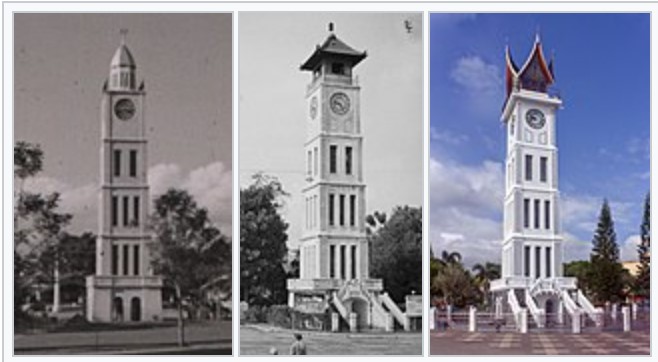Jam Gadang (clock tower, literally ‘big tower’) is a term for a 26-meter-high clock tower in the center of Bukittinggi city, West Sumatra. As the city’s major landmark, Jam Gadang is located on Jalan Istana, Bukit Cangang village, Guguk Panjang subdistrict, Bukittinggi city. It is one of the Dutch East Indies government’s monuments, which is currently almost a century old. The clock tower was built in 1926 as a gift from Wilhelmine of Prussia, Queen of the Netherlands, to Rook Maker, Secretary of Fort de Kock (now the city of Bukittinggi) during the reign of the Dutch East Indies. The groundbreaking or sod-turning ceremony was carried out by Rook Maker’s eldest son who was still six years old at the time.
Jam Gadang was designed by an Minangnese architect, Yazid Rajo Mangkuto from Koto Gadang, an area not far from where Jam Gadang stands. The executor of the construction himself was recorded as Haji Moran with his foreman St. Ameh’s Teeth. It has a floor plan area of 13 x 4 meters and 26 meters high. At one level below the top, there is a large clock of 80 cm in diameter on the four sides. That is why locals call it Jam Gadang, literally meaningful large or big clock. The clock in the tower is said to have been imported directly from Rotterdam via the port of Teluk Bayur.
One of the uniqueness of the Jam Gadang is that the number four on the clock is not written as “IV”, but rather the four letters I, or “IIII”. Various stories have been around associated with the Roman numeral ‘III,’ which is not written ‘IV.’ The number IV on the clock tower is associated with a mystical story in which sacrifices were made to four bricklayers and egg whites as reinforcement of the building.
Yet, according to some experts, Jam Gadang, which reads the number 4 with the Roman ‘IIII,’ has a different perspective. They revealed that the number 4 was originally written in Roman numerals, with the letter ‘I’ repeated four times. It was later changed to the Roman numeral 4 to ‘IV’ and began to be used during the reign of Louis XIV.
The number 4 on the Jam Gadang, which is inscribed with the Roman numeral ‘IIII,’ is following the Roman numeral 4’s initial form of writing. It may have more to do with the Queen of the Netherlands’ decision to keep the Roman numeral 4. As it was originally written so that there would be no rebellion during her reign at the time.
The clock machine used in this monument is a rare item produced by only two units by the Vortmann Recklinghausen factory, Germany. The second unit of its type is still used in the legendary clock tower of the City of London, England, namely Big Ben. It has been said that Jam Gadang was built without iron buffer or mortar, only using a mixture of lime, egg white, and white sand.
Jam Gadang building consists of 5 floors. The bottom part is similar to the building footprint. The next building is like a cube, each of which is slightly smaller than the bottom building. To get to the top, we have to pass quite steep stairs and only enough for one adult’s body. Getting to the top, the room gets narrower. But once you reach the top, the scenery that is presented is incredibly beautiful. We can enjoy the charming nature of the Bukittinggi city.
Before reaching the top, we will pass an old wooden wardrobe. Therein contains a giant clockwork. The metal frame protrusions in the cupboard imagined me an ancient scale. A number of giant gears can be seen there. A small wire rope runs through the ceiling hole, connected to the end of the bat in the upper room to pull it against a bell when the short needle reads 00 o’clock.
The bell is located on the top of the square building. The copper bell reads “Vortmann Relinghausen, I.W Germany”. Vortman last name Benhard Vortmann, the watchmaker. Recklinghausen, the name of the city in Germany where this movement was produced in 1892. Since its establishment, the 26-meter-high clock tower has undergone three changes in the shape of its roof. Initially founded during the reign of the Dutch East Indies, the roof at the Jam Gadang is round with a statue of a rooster facing east on it. The point is that the Kurai, Banuhampu, and Sarik Sungai Puar people wake up in the morning when the rooster crows. During the Japanese occupation, the shape of the roof was changed to the shape of a pagoda.
After Indonesia gained its independence in 1945, the roof was remodeled into a bagonjong roof which is a main feature of the original Minangkabau traditional house, namely the Rumah Gadang. The last renovation of Jam Gadang was undertaken by the Cultural Heritage Preservation Agency (BPCB) in 2010 supported by the Bukittinggi city administration and the Dutch Embassy in Jakarta. The renovation was completed on the Bukitinggi’s 262nd anniversary on December 22, 2010.
As a city where Jam Gadang stands, Bukittinggi is one of the largest cities in West Sumatra and is set in the Minangkabau highlands close to the volcanoes of Mount Singgalang and the active Mount Merapi. At 930 metres above sea level, it is popular with visitors for its cool climate and is a perfect city to explore on foot. It has breathtaking views out to the Sianok Grand Canyon – also walking distance to ‘Jam Gadang’ and Pasar Atas and Pasar Bawah, the traditional downtown markets in the centre of Bukittinggi. Along with its natural attractions, the real charm of Bukittinggi is bound to its demographic and cultural features. The characteristics of the city’s residents make the city even more appealing. There’s an inclusive nature to the Bukittinggi residents that has played a central role in the city’s draw.

